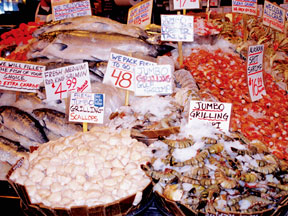The safety of seafood from the Gulf of Mexico became a central concern following the Deepwater Horizon blowout in April 2010.
 Even after previously closed Gulf waters began reopening in summer 2010, consumer confidence in the safety of seafood from it remained shaky. Now a new review lead authored by Julia Gohlke, Ph.D., assistant professor of environmental health sciences in UAB’s School of Public Health, affirms that levels of polycyclic aromatic hydrocarbons (PAHs) found thus far in Gulf seafood samples have been well below levels that would be of concern for human health.
Even after previously closed Gulf waters began reopening in summer 2010, consumer confidence in the safety of seafood from it remained shaky. Now a new review lead authored by Julia Gohlke, Ph.D., assistant professor of environmental health sciences in UAB’s School of Public Health, affirms that levels of polycyclic aromatic hydrocarbons (PAHs) found thus far in Gulf seafood samples have been well below levels that would be of concern for human health.
The article, “A Review of Seafood Safety after the Deepwater Horizon Blowout,” was published online May 12 in the peer-reviewed journal Environmental Health Perspectives (EHP). Gohlke and her co-authors reviewed federal tests of seafood in the Gulf, with samples taken from waters off the Louisiana, Mississippi, Alabama and Florida coastlines. The concern was that levels of polycyclic aromatic hydrocarbons (PAHs), pollutants that occur in oil and tar deposits and are carcinogenic, would be making the marine life unsafe to eat, but what they found was that the numbers confirm the seafood is safe.
“Based on the amount of oil released, this result is quite surprising,” Gohlke says, “but we also know the Gulf’s warm waters and the use of dispersants may have contributed to what we’re seeing now. The oil can be broken down much faster in warm water and the use of dispersants at the wellhead may have allowed for even more rapid breakdown, as well as sedimentation of the oil.”
Still, Gohlke says there are long-term concerns; therefore, further testing of fish, shrimp and other ocean edibles should continue for the foreseeable future.
The authors of the EHP review developed several recommendations after reviewing toxicology reports from oil spills worldwide. They also examined protocols for reopening fisheries after the Deepwater Horizon blowout and previous spills.
They recommend that Gulf seafood continue to be tested for PAHs in light of potential recontamination from disturbance and redistribution of uncaptured oil.
After previous spills, PAH levels have been elevated in fish and shellfish for periods ranging from several weeks to several years. Little is known about the toxicity of dispersants applied deep under water, as during the Deepwater Horizon disaster, but given the lack of information on environmental persistence of dioctyl sodium sulfosuccinate (DOSS) — a primary component of the two chemical dispersants used to clean the oil in the water — they also recommend continued testing for this compound.
“The oil spill is unique in several respects — the depth at which the oil was released, the unprecedented amount of oil leaked and the amount of dispersants used at depth,” Gohlke says. “Reports have indicated there is still oil on the sea floor. If that’s the case, it could still work its way up the food chain. That’s why we advocate for long-term monitoring of both PAHs and metals.”
Additional testing is recommended for metals including mercury, cadmium and lead, which are found in crude oil and in drilling fluids.
“Based on evidence from previous oil spills, it is in the interest of public health to monitor levels of metals in seafood,” Gohlke says. Some metals are known to bioaccumulate in seafood and can damage the developing nervous systems of infants and young children.
According to the authors, continued monitoring for PAHs and DOSS in the Gulf of Mexico and additional testing for metals will protect consumers now and also provide valuable information for preparedness in response to future spills.
The study’s co-authors include Dzigbodi Doke, a UAB environmental health doctoral student; Meghan Tipre, a UAB epidemiology doctoral student; Mark Leader, research scientist in epidemiology; and Timothy Fitzgerald with the Environmental Defense Fund, in Washington, D.C. The work was supported in part by the Walton Family Foundation.
The Deepwater Horizon blowout occurred April 20, 2010, and the U.S. National Oceanic and Atmospheric Administration (NOAA) began closing commercial fisheries May 2, 2010. By June 21, 37 percent (225,290 square kilometers) of the Gulf of Mexico Exclusive Economic Zone was closed to commercial fishing. NOAA began reopening federal waters to fishing June 23, 2010, after sensory and chemical testing of Gulf seafood by the U.S. Food and Drug Administration (FDA), NOAA, and state agencies indicated it was safe to eat. The well was capped July 15, and as of April 19, 2011, all federal waters had been reopened to fishing.
Gohlke also is working on other independent testing projects in the Gulf. She was awarded a $20,000 pilot grant from UAB to study the impact of the spill on the environment. That helped lead her to a position on the advisory board of the Gulf Reef Fisherman’s Shareholder’s Alliance, from which she is helping that group develop an independent testing scheme to ensure the seafood being sold is safe.
“It’s a great market-based program initiated by fisherman to help restore consumer confidence in their product,” Gohlke says.
Learn more about this initiative at mygulfwild.com.
